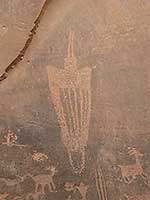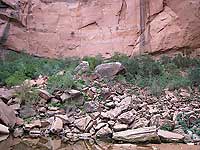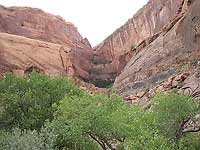-cmyk.jpg) Shortly after dusk - under the cloak of darkness - a dramatic transformation occurs. That’s when the cigar-shaped petals of the sacred datura, commonly known as moonflowers, open to reveal the white Cinderella beauty of their large, trumpet-shaped flowers. As a night bloomer this perennial plant, which is related to tobacco, releases a sweet fragrance to attract the sphinx moth and other nocturnal pollinators. In clear weather their distinctive flowers wither away a few hours after sunrise, but on overcast, cooler nights they tend to open earlier and linger longer the next morning. Shortly after dusk - under the cloak of darkness - a dramatic transformation occurs. That’s when the cigar-shaped petals of the sacred datura, commonly known as moonflowers, open to reveal the white Cinderella beauty of their large, trumpet-shaped flowers. As a night bloomer this perennial plant, which is related to tobacco, releases a sweet fragrance to attract the sphinx moth and other nocturnal pollinators. In clear weather their distinctive flowers wither away a few hours after sunrise, but on overcast, cooler nights they tend to open earlier and linger longer the next morning.
At the entrance to Moonflower Canyon on a chilly, overcast morning these captivating blooms are on display by the dozens. On this crisp day at the end of August I am savoring an out-of-season coolness while it lasts, as well as the enchantment of a fairy tale garden spread out before me. This poetic scene is enhanced by the bouncing-down-the-scale melody of the canyon wren and the weird whistles and rattling calls of the yellow-breasted chat.
 For centuries Native Americans harvested these hallucinogenic plants to use in their rites of passage and religious ceremonies. The petroglyphs located at the mouth of the canyon depict some of these traditions where they recorded their visions, clan symbols and current events. The first evidence of a prehistoric people in southeast Utah can be traced back to around 6,000 B.C. These bands of hunter/gatherers, known as the Desert Archaic or Barrier Canyon, were constantly on the move. The Basketmakers, a semi-agrarian society replaced or evolved from them around 0 A.D., a domain that lasted only 800 to 900 years. For centuries Native Americans harvested these hallucinogenic plants to use in their rites of passage and religious ceremonies. The petroglyphs located at the mouth of the canyon depict some of these traditions where they recorded their visions, clan symbols and current events. The first evidence of a prehistoric people in southeast Utah can be traced back to around 6,000 B.C. These bands of hunter/gatherers, known as the Desert Archaic or Barrier Canyon, were constantly on the move. The Basketmakers, a semi-agrarian society replaced or evolved from them around 0 A.D., a domain that lasted only 800 to 900 years.
An easy half-mile round trip walk on a mostly sandy streambed is all it takes to explore this sheer-walled box canyon with its distinct changes from a dry desert habitat to a jungly, water-loving environment. As the temperature rises on this end of summer day, the tall, wide-in-girth cottonwoods provide welcoming shade as their heart-shaped leaves rustle in the breeze. After passing through the boundary of Behind The Rocks Wilderness Study Area the sound of traffic fades away as I stroll by the eight walk-in campsites. Now wherever the paintbrush grows, the hummingbirds go as they feast on that sweet nectar. Darting from flower to flower their foreheads are powdered yellow with pollen making them look like they’re wearing a mask for a Halloween party.
-cmyk.jpg) Saltbush, prickly pear and junipers claim the dryer turf nearest the towering Navajo Sandstone walls, while squawbush, Gambel’s oak and Fremont’s mahonia (commonly referred to as desert holly) fight for their own square feet of space. Soon-to-bloom rabbitbrush announces the approach of fall, while the brilliance of scarlet gilia still lingers on. About half way up the canyon, the willows, water birch, tall grass, and other lush vegetation revel in the increasing wet conditions. Meanwhile in the midst of this run-amok growth, the precious pale yellow Bridges evening primrose manages to assert its own identity. Saltbush, prickly pear and junipers claim the dryer turf nearest the towering Navajo Sandstone walls, while squawbush, Gambel’s oak and Fremont’s mahonia (commonly referred to as desert holly) fight for their own square feet of space. Soon-to-bloom rabbitbrush announces the approach of fall, while the brilliance of scarlet gilia still lingers on. About half way up the canyon, the willows, water birch, tall grass, and other lush vegetation revel in the increasing wet conditions. Meanwhile in the midst of this run-amok growth, the precious pale yellow Bridges evening primrose manages to assert its own identity.
Almost to the end of the trail I’m twisting and ducking in a desperate attempt to avoid the three-leaf scourge of poison ivy that is hanging over the trail. Then at a vertical pour-off the canyon bumps to an abrupt halt, and I amble over to a small pond that feeds a tiny stream before it disappears underground. A heavy downpour (usually a thunderstorm) can make a huge difference when a raging rush of water flooding through these narrow walls takes everything in its path. With that in mind, I keep a wary eye on the gathering storm clouds!
Looking forward to a quiet, overdue breakfast, I comfortably stretch out on a large rock. I’m enjoying this serenity away from the intrusions of every day life when “ka-boom” – somewhere, too-close-for-comfort - a rock hits the ground, followed by  several more loud ka-booms! Startled I jump to my feet - and oops - my egg salad sandwich flips off my lap and in to a bog of mud. But then I shouldn’t be surprised. The pile up of boulders tells the story that this happens all the time. several more loud ka-booms! Startled I jump to my feet - and oops - my egg salad sandwich flips off my lap and in to a bog of mud. But then I shouldn’t be surprised. The pile up of boulders tells the story that this happens all the time.
After the rock fall finally stops, I dig out my other munchies, as several mischievous chipmunks scurry around looking for handouts. Then settling in once again, I gradually return to a calm, being-by-myself repose. Now the only sounds I hear are: the squawk of a scrub jay as he eats an acorn - the steady drip-drip of water - the mewing call of a spotted towhee - the persistent drone of a mosquito buzzing in my ear - and the basal voices of ravens echoing off the canyon walls.
Intrigued with the aquatic life of this pond, I move closer to study it. Camouflaged leopard frogs are seldom seen until with a squeal they leap to the safety of the shallow water. Insects called boatmen use their side-by-side appendages for oars. Fascinated I watch them row to the bottom and back up again. Then there’s the amazing feat of the water skimmers, which have earned the nickname, “Jesus Bugs,” for their unique talent of using water suspension to float and waltz across the surface of the water. Meanwhile metallic blue dragonflies, like hovering helicopters, patrol from above.
 With the passing of another summer, the annual low level of this pond makes me realize the big advantage of this accessible, year round trail – the constant changes from one season to the next. During the summer months deep shade and cool, flowing water provide a sanctuary from the desert heat. Following that oven baking season, I anticipate my favorite time of year – the switch to the crisp radiant colors of fall when the fluttery cottonwood leaves shimmer in the sun. During the winter I am fond of the silent piercing cold atmosphere with its frosty, iced-over patterns as I wait for the welcome warmth of spring and another big fling of wildflowers. With the passing of another summer, the annual low level of this pond makes me realize the big advantage of this accessible, year round trail – the constant changes from one season to the next. During the summer months deep shade and cool, flowing water provide a sanctuary from the desert heat. Following that oven baking season, I anticipate my favorite time of year – the switch to the crisp radiant colors of fall when the fluttery cottonwood leaves shimmer in the sun. During the winter I am fond of the silent piercing cold atmosphere with its frosty, iced-over patterns as I wait for the welcome warmth of spring and another big fling of wildflowers.
All these treasures and so much more are a mere ten minutes away from the hustle and bustle of town. To access them, at the south end of Main Street turn west on to Kane Creek Blvd. at the corner of McDonalds and Burger King. Then proceed three miles to the parking area on the left side of the road. Here you will find a soothing haven that feels far removed from our modern day world.
|